Abstract
The purpose of this study was to examine the racial/ethnic differences in self- reported health problems and herbal use as a self-care practice between white American and African-American older women, and between herbal users and nonusers. Two data sets collected in 1998 and 2002 were combined to perform this study. The total sample (143 participants) consisted of 85 white Americans and 58 African-American women > or = 65 years, living independently in the community. While there were statistically significant differences in education (chi-squared = 19.085, p=0.0001) and annual income (chi-squared = 21.905, p=0.0001) between white American and African-American women, no differences were found in the use of herbals between the two groups. There was a significant relationship between the number of herbals used and the number of nonprescribed medications used (gamma = 0.320, p<0.01). No relationship was detected between the number of herbals used and self-reported health problems (gamma = 0.075, p<0.01), and between the number of nonprescribed medications used and self-reported health problems (gamma = 0.047, p<0.01). White American herbal users utilized the highest number of combination products (prescribed, nonprescribed and herbals) of all. African-American herbal users indicated a higher number of combination products than African-American nonusers. Results suggested that herbals were used as a complementary rather than an alternative therapy to manage perceived health concerns in both groups.
Full text
PDF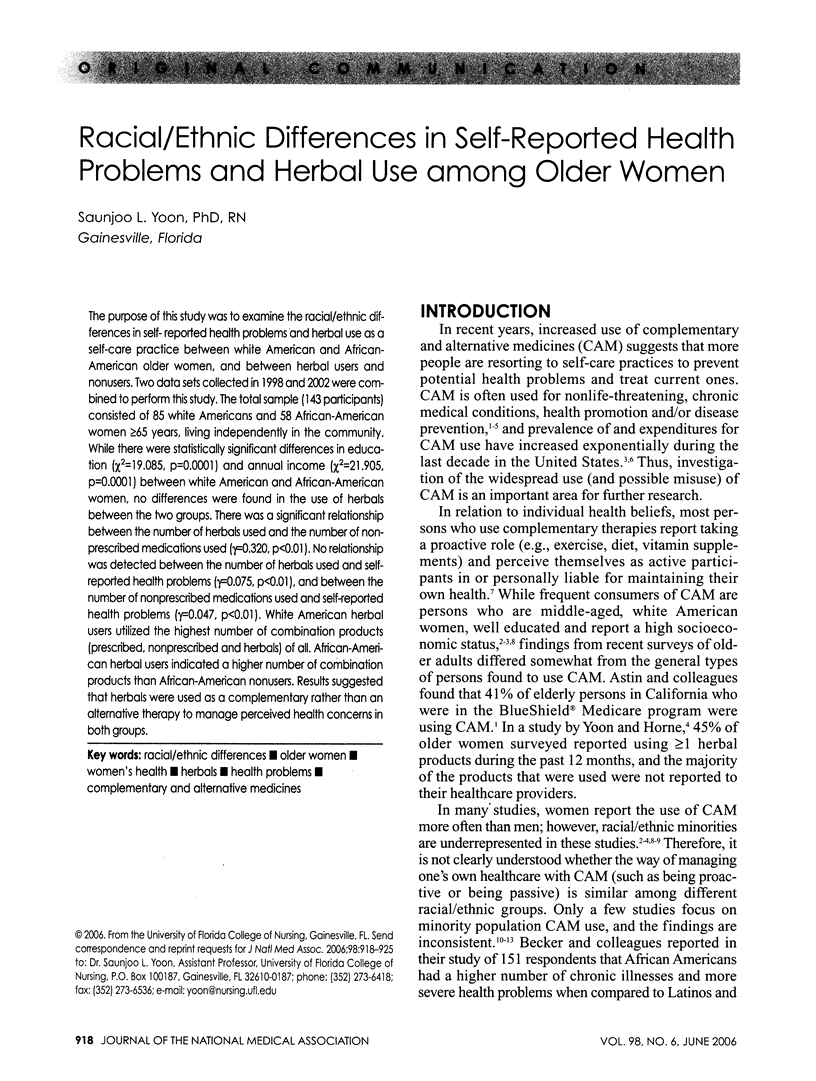
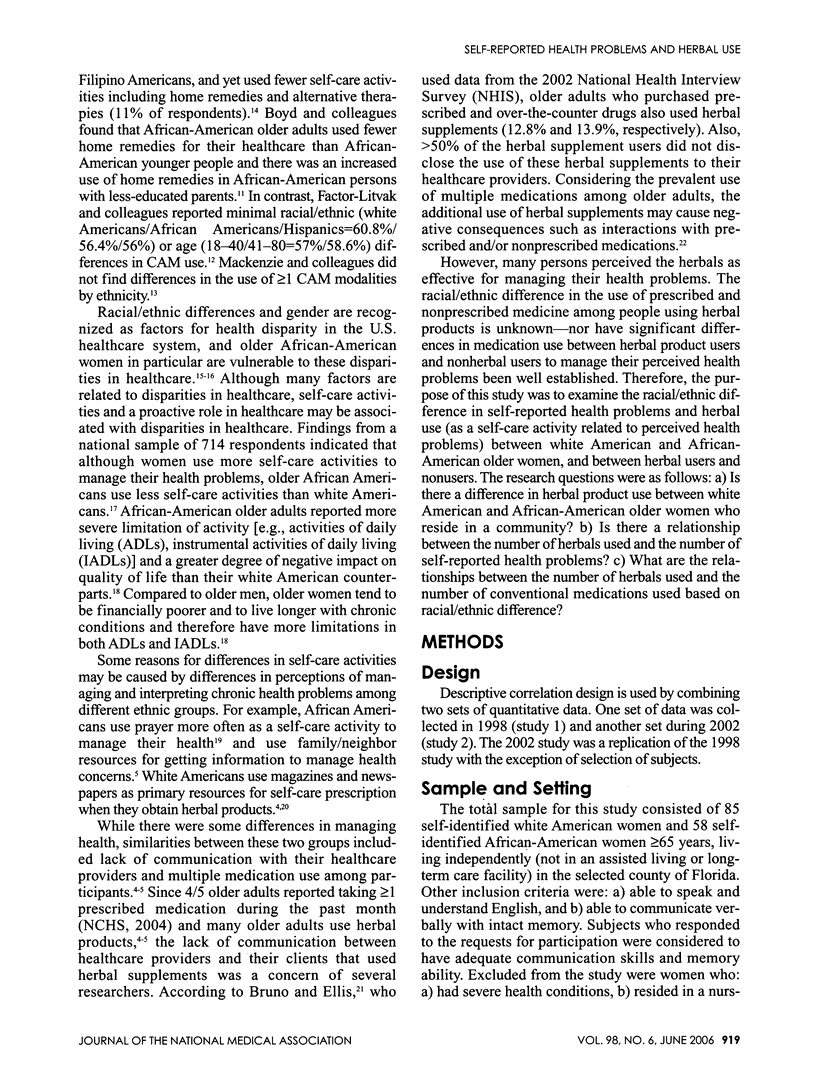
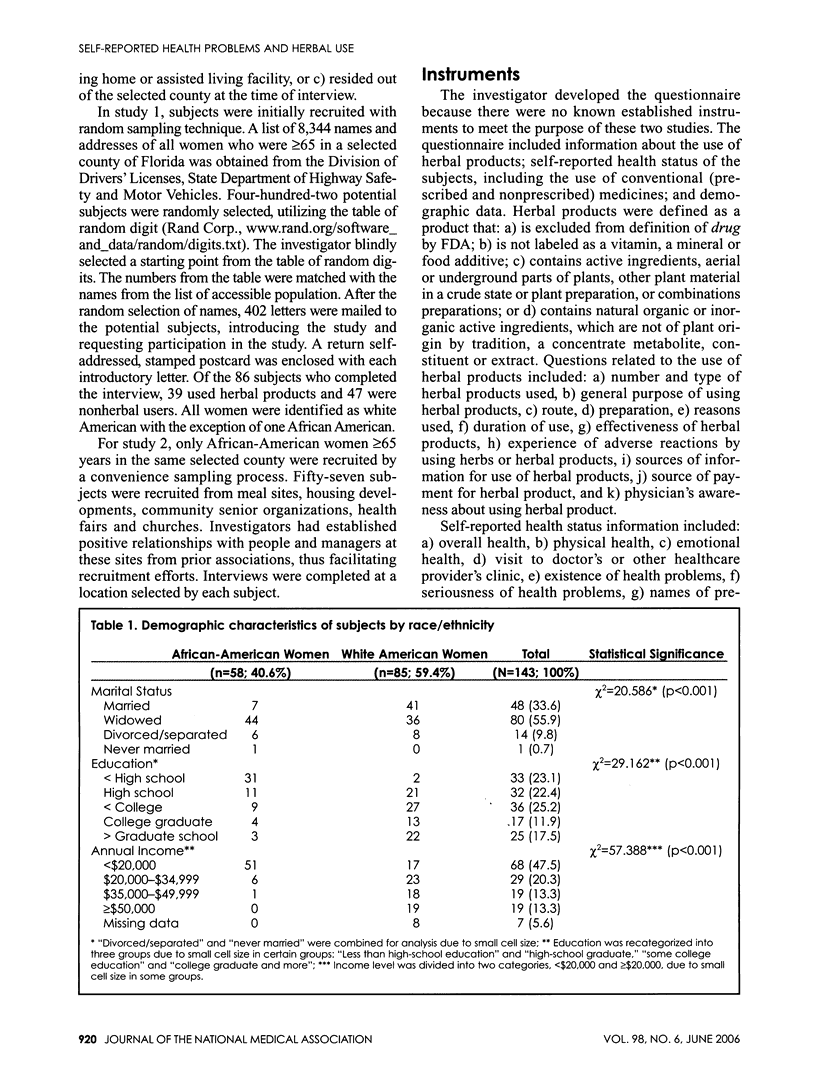
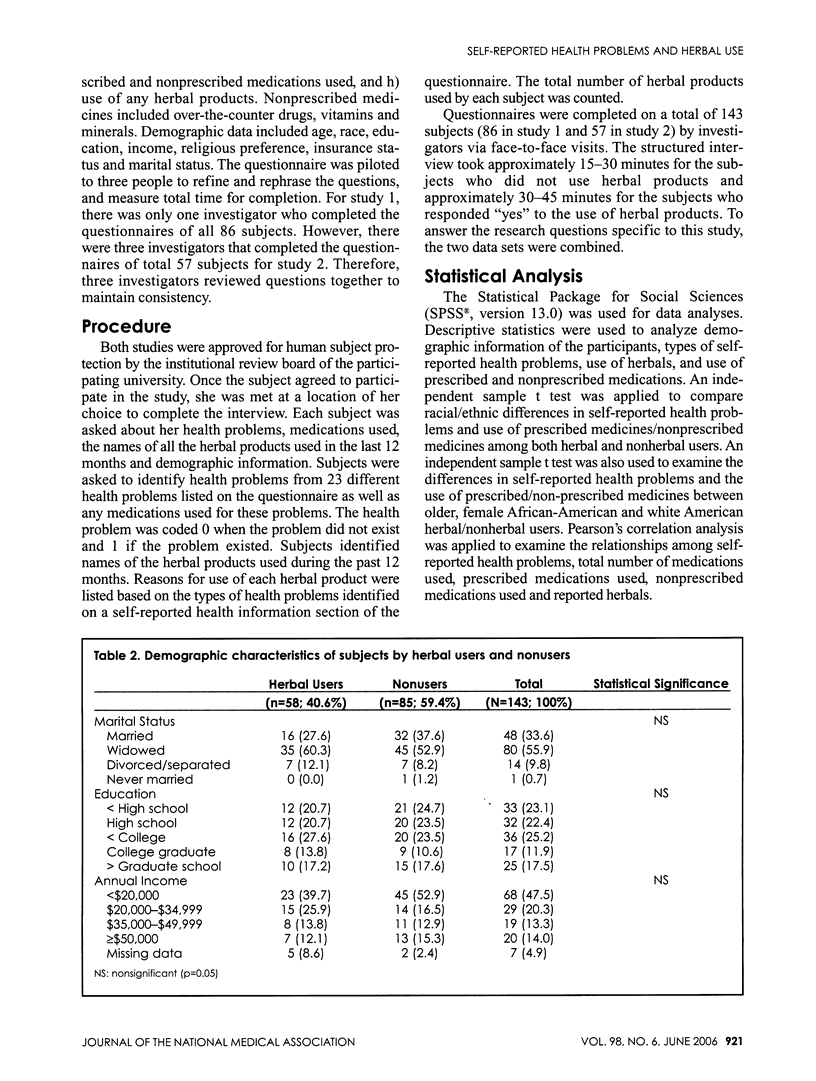
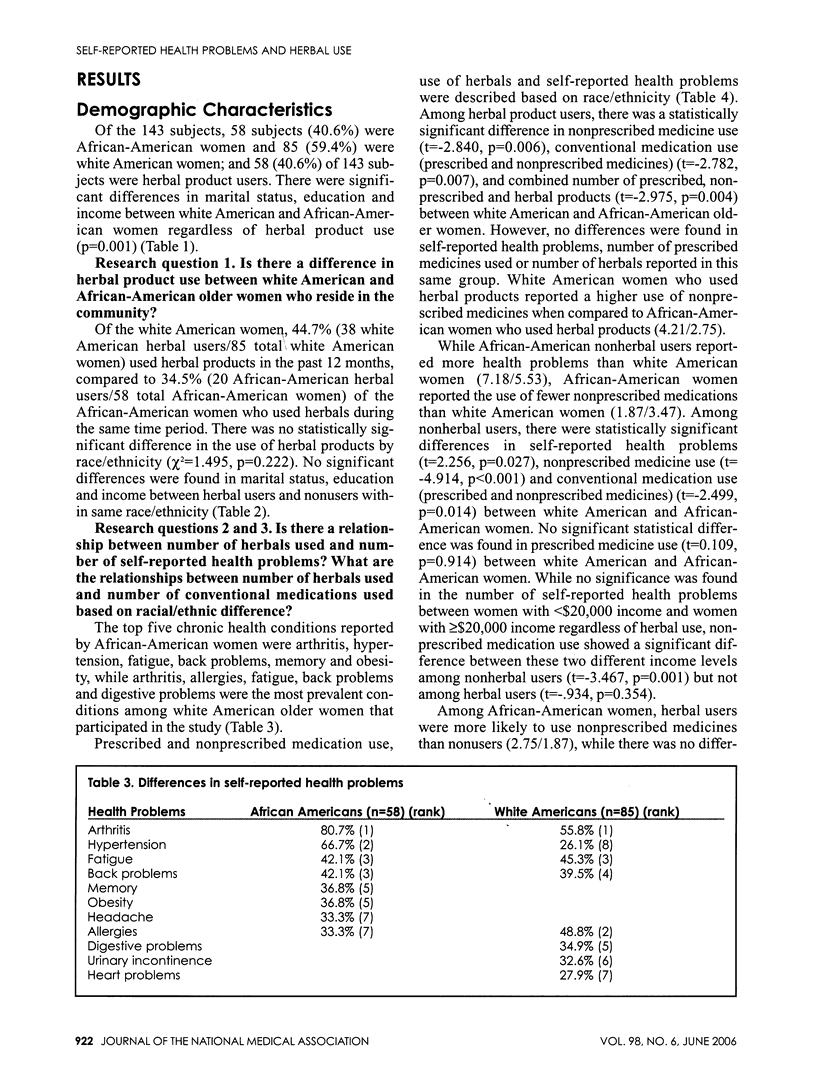
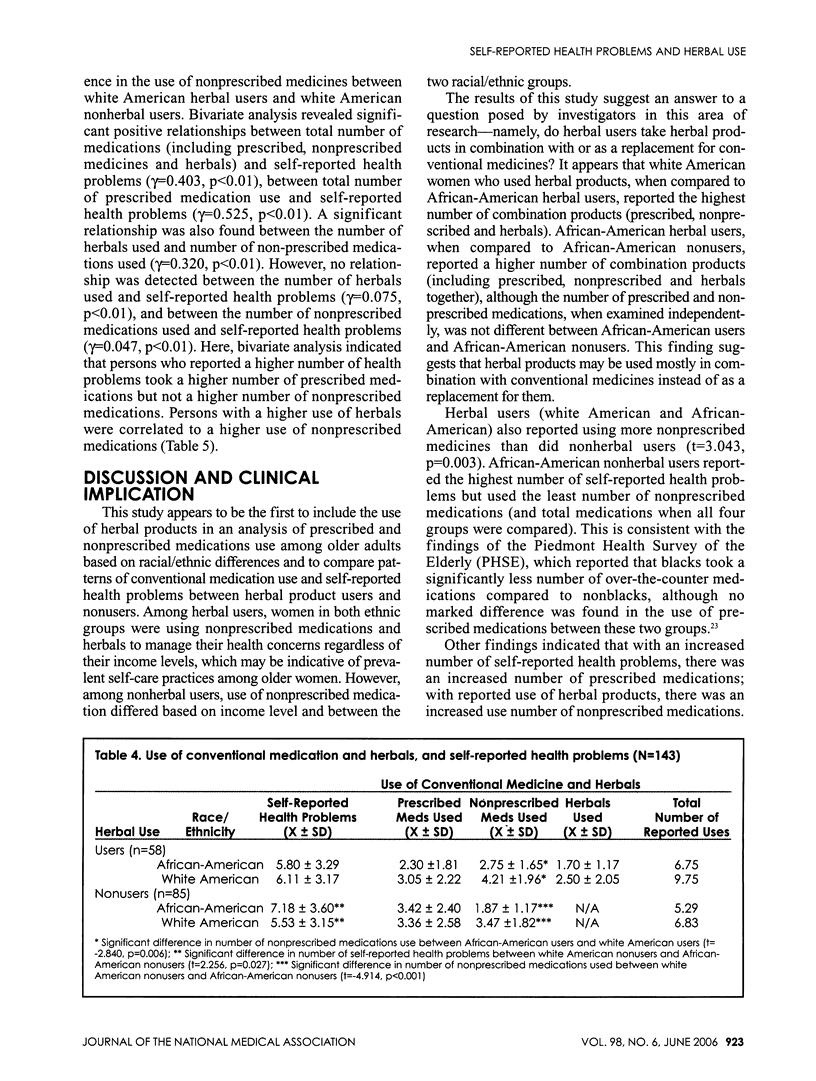


Selected References
These references are in PubMed. This may not be the complete list of references from this article.
- Astin J. A., Pelletier K. R., Marie A., Haskell W. L. Complementary and alternative medicine use among elderly persons: one-year analysis of a Blue Shield Medicare supplement. J Gerontol A Biol Sci Med Sci. 2000 Jan;55(1):M4–M9. doi: 10.1093/gerona/55.1.m4. [DOI] [PubMed] [Google Scholar]
- Astin J. A. Why patients use alternative medicine: results of a national study. JAMA. 1998 May 20;279(19):1548–1553. doi: 10.1001/jama.279.19.1548. [DOI] [PubMed] [Google Scholar]
- Barnes Patricia M., Powell-Griner Eve, McFann Kim, Nahin Richard L. Complementary and alternative medicine use among adults: United States, 2002. Adv Data. 2004 May 27;(343):1–19. [PubMed] [Google Scholar]
- Barnett Marina C., Cotroneo Margaret, Purnell Joseph, Martin Danielle, Mackenzie Elizabeth, Fishman Alfred. Use of CAM in local African-American communities: community-partnered research. J Natl Med Assoc. 2003 Oct;95(10):943–950. [PMC free article] [PubMed] [Google Scholar]
- Becker G., Beyene Y., Newsom E. M., Rodgers D. V. Knowledge and care of chronic illness in three ethnic minority groups. Fam Med. 1998 Mar;30(3):173–178. [PubMed] [Google Scholar]
- Bent Stephen, Ko Richard. Commonly used herbal medicines in the United States: a review. Am J Med. 2004 Apr 1;116(7):478–485. doi: 10.1016/j.amjmed.2003.10.036. [DOI] [PubMed] [Google Scholar]
- Boyd E. L., Taylor S. D., Shimp L. A., Semler C. R. An assessment of home remedy use by African Americans. J Natl Med Assoc. 2000 Jul;92(7):341–353. [PMC free article] [PubMed] [Google Scholar]
- Bruno Jeffrey J., Ellis Jeffrey J. Herbal use among US elderly: 2002 National Health Interview Survey. Ann Pharmacother. 2005 Mar 1;39(4):643–648. doi: 10.1345/aph.1E460. [DOI] [PubMed] [Google Scholar]
- Dunn K. S., Horgas A. L. The prevalence of prayer as a spiritual self-care modality in elders. J Holist Nurs. 2000 Dec;18(4):337–351. doi: 10.1177/089801010001800405. [DOI] [PubMed] [Google Scholar]
- Eisenberg D. M., Davis R. B., Ettner S. L., Appel S., Wilkey S., Van Rompay M., Kessler R. C. Trends in alternative medicine use in the United States, 1990-1997: results of a follow-up national survey. JAMA. 1998 Nov 11;280(18):1569–1575. doi: 10.1001/jama.280.18.1569. [DOI] [PubMed] [Google Scholar]
- Factor-Litvak P., Cushman L. F., Kronenberg F., Wade C., Kalmuss D. Use of complementary and alternative medicine among women in New York City: a pilot study. J Altern Complement Med. 2001 Dec;7(6):659–666. doi: 10.1089/10755530152755216. [DOI] [PubMed] [Google Scholar]
- Geronimus A. T. Black/white differences in the relationship of maternal age to birthweight: a population-based test of the weathering hypothesis. Soc Sci Med. 1996 Feb;42(4):589–597. doi: 10.1016/0277-9536(95)00159-x. [DOI] [PubMed] [Google Scholar]
- Geronimus A. T. Understanding and eliminating racial inequalities in women's health in the United States: the role of the weathering conceptual framework. J Am Med Womens Assoc. 2001 Fall;56(4):133-6, 149-50. [PubMed] [Google Scholar]
- Hanlon J. T., Fillenbaum G. G., Burchett B., Wall W. E., Jr, Service C., Blazer D. G., George L. K. Drug-use patterns among black and nonblack community-dwelling elderly. Ann Pharmacother. 1992 May;26(5):679–685. doi: 10.1177/106002809202600514. [DOI] [PubMed] [Google Scholar]
- Kart C. S., Engler C. A. Predisposition to self-health care: who does what for themselves and why? J Gerontol. 1994 Nov;49(6):S301–S308. doi: 10.1093/geronj/49.6.s301. [DOI] [PubMed] [Google Scholar]
- Kelner M., Wellman B. Health care and consumer choice: medical and alternative therapies. Soc Sci Med. 1997 Jul;45(2):203–212. doi: 10.1016/s0277-9536(96)00334-6. [DOI] [PubMed] [Google Scholar]
- Mackenzie Elizabeth R., Taylor Lynne, Bloom Bernard S., Hufford David J., Johnson Jerry C. Ethnic minority use of complementary and alternative medicine (CAM): a national probability survey of CAM utilizers. Altern Ther Health Med. 2003 Jul-Aug;9(4):50–56. [PubMed] [Google Scholar]
- Ni Hanyu, Simile Catherine, Hardy Ann M. Utilization of complementary and alternative medicine by United States adults: results from the 1999 national health interview survey. Med Care. 2002 Apr;40(4):353–358. doi: 10.1097/00005650-200204000-00011. [DOI] [PubMed] [Google Scholar]
- Yoon S. J., Horne C. H. Herbal products and conventional medicines used by community-residing older women. J Adv Nurs. 2001 Jan;33(1):51–59. doi: 10.1046/j.1365-2648.2001.01637.x. [DOI] [PubMed] [Google Scholar]
- Yoon Saunjoo L., Horne Claydell H., Adams Collette. Herbal product use by African American older women. Clin Nurs Res. 2004 Nov;13(4):271–288. doi: 10.1177/1054773804267877. [DOI] [PubMed] [Google Scholar]
- Yoon Saunjoo Lee, Horne Claydell H. Perceived health promotion practice by older women: use of herbal products. J Gerontol Nurs. 2004 Jul;30(7):9–15. doi: 10.3928/0098-9134-20040701-05. [DOI] [PubMed] [Google Scholar]


